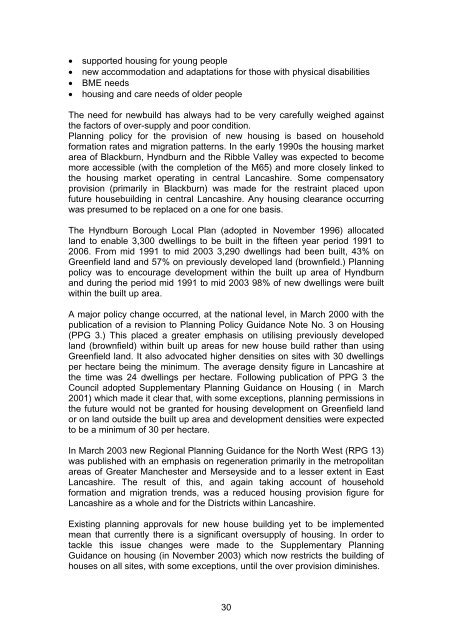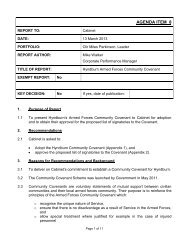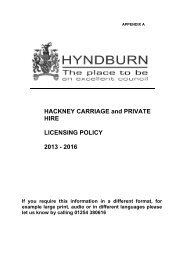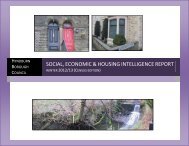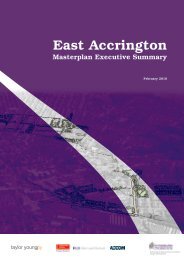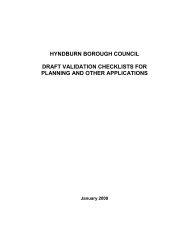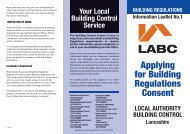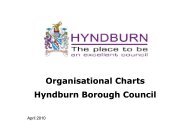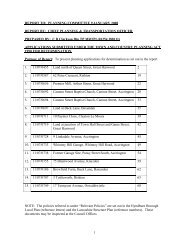A Profile of Hyndburn - 2004 - Hyndburn Borough Council
A Profile of Hyndburn - 2004 - Hyndburn Borough Council
A Profile of Hyndburn - 2004 - Hyndburn Borough Council
You also want an ePaper? Increase the reach of your titles
YUMPU automatically turns print PDFs into web optimized ePapers that Google loves.
• supported housing for young people• new accommodation and adaptations for those with physical disabilities• BME needs• housing and care needs <strong>of</strong> older peopleThe need for newbuild has always had to be very carefully weighed againstthe factors <strong>of</strong> over-supply and poor condition.Planning policy for the provision <strong>of</strong> new housing is based on householdformation rates and migration patterns. In the early 1990s the housing marketarea <strong>of</strong> Blackburn, <strong>Hyndburn</strong> and the Ribble Valley was expected to becomemore accessible (with the completion <strong>of</strong> the M65) and more closely linked tothe housing market operating in central Lancashire. Some compensatoryprovision (primarily in Blackburn) was made for the restraint placed uponfuture housebuilding in central Lancashire. Any housing clearance occurringwas presumed to be replaced on a one for one basis.The <strong>Hyndburn</strong> <strong>Borough</strong> Local Plan (adopted in November 1996) allocatedland to enable 3,300 dwellings to be built in the fifteen year period 1991 to2006. From mid 1991 to mid 2003 3,290 dwellings had been built, 43% onGreenfield land and 57% on previously developed land (brownfield.) Planningpolicy was to encourage development within the built up area <strong>of</strong> <strong>Hyndburn</strong>and during the period mid 1991 to mid 2003 98% <strong>of</strong> new dwellings were builtwithin the built up area.A major policy change occurred, at the national level, in March 2000 with thepublication <strong>of</strong> a revision to Planning Policy Guidance Note No. 3 on Housing(PPG 3.) This placed a greater emphasis on utilising previously developedland (brownfield) within built up areas for new house build rather than usingGreenfield land. It also advocated higher densities on sites with 30 dwellingsper hectare being the minimum. The average density figure in Lancashire atthe time was 24 dwellings per hectare. Following publication <strong>of</strong> PPG 3 the<strong>Council</strong> adopted Supplementary Planning Guidance on Housing ( in March2001) which made it clear that, with some exceptions, planning permissions inthe future would not be granted for housing development on Greenfield landor on land outside the built up area and development densities were expectedto be a minimum <strong>of</strong> 30 per hectare.In March 2003 new Regional Planning Guidance for the North West (RPG 13)was published with an emphasis on regeneration primarily in the metropolitanareas <strong>of</strong> Greater Manchester and Merseyside and to a lesser extent in EastLancashire. The result <strong>of</strong> this, and again taking account <strong>of</strong> householdformation and migration trends, was a reduced housing provision figure forLancashire as a whole and for the Districts within Lancashire.Existing planning approvals for new house building yet to be implementedmean that currently there is a significant oversupply <strong>of</strong> housing. In order totackle this issue changes were made to the Supplementary PlanningGuidance on housing (in November 2003) which now restricts the building <strong>of</strong>houses on all sites, with some exceptions, until the over provision diminishes.30


